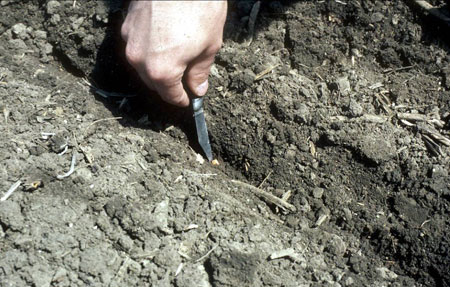Preseason Field Check of Planting Equipment
Before starting to plant, take time to check on how well your planter will perform in the field. As with any piece of equipment, the operator's manual is the starting point for the initial settings and adjustments. Recommendations and trouble-shooting tips are in the manual and also available from others who own and operate similar equipment.

- Level the planter in the field, making sure that the toolbar is at the proper height and leveled front-to-rear, perhaps even slightly "tail" down. This allows for the full range of movement of the parallel links on the row units, helps keep the planter on the row, and aids in seed-to-soil contact. If the toolbar is too high, the downpressure springs are ineffective. If the toolbar is too low, you may break downpressure springs by over extending them.
- Make sure that the planter carrying wheels are exactly centered between the rows and that they are carrying some weight while setting the toolbar height. This is especially important for producers using the ridge-plant system to help keep the planter on top of the ridge. Remember that the toolbar height will change by the height of the ridges and needs to be reset as the carrying wheels settle into the furrow.
- Once the planter is leveled, try blind planting with no seed in the boxes or other products on the planter (everything empty). Stop with the planting units in the ground and check to see if the depth gauge wheels are in firm contact with the soil surface. If they are not, tighten the downpressure springs (or increase the air pressure on the airbags, if so equipped) and try planting again. If you cannot tighten the springs, you may have to add extra springs or add weight directly to the row unit to get the gauge wheels in firm contact with the soil. If you cannot turn the depth gauge wheels slightly, especially on wetter soils, you may have to reduce the downpressure to avoid over-compacting the soil next to the seed-vee.
- Check to see if you can slip the seeding mechanism drive wheels as the downpressure springs will be lifting the toolbar. You may have to add weight to the planter frame for the springs or airbags to work against and to keep the drive wheels firmly on the ground to reduce slip. Don't loosen the springs to get the drive wheels back in contact with the soil as penetration to seeding depth is necessary. Extra weight will be needed for dry soils or heavy residue and on planters with inter-plant units.
- Place a small amount of seed into a couple of seed boxes and plant a short distance. Check seeding depth, seed-to-soil contact, seeding depth uniformity, and seed spacing uniformity. Evaluate seed-vee closing and check to make sure you're not over compacting the seed zone or packing below the seeding depth.
Make the necessary adjustments or add the required equipment to improve planter performance and check the planter again. Even though a preseason planter check was made, all of these items should be rechecked when actual planting begins and as conditions change during the planting season.
Paul Jasa
Extension Engineer